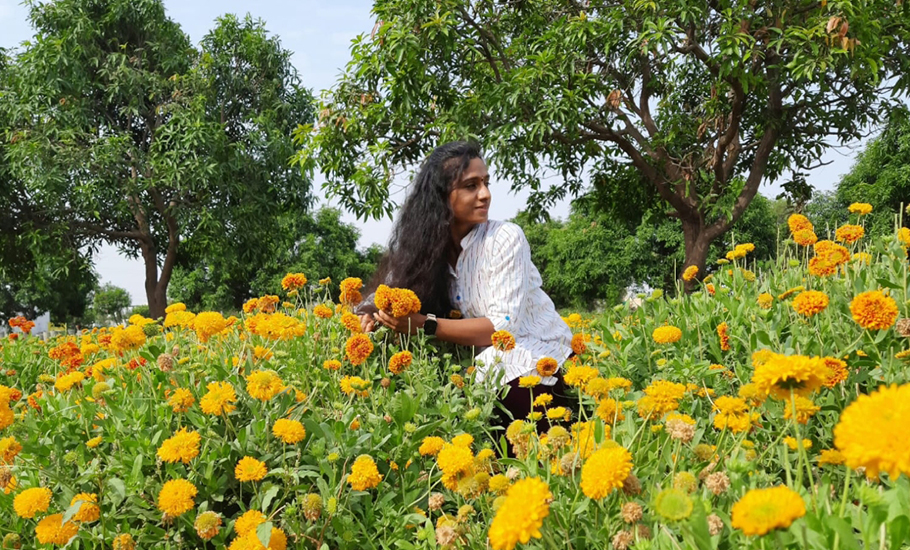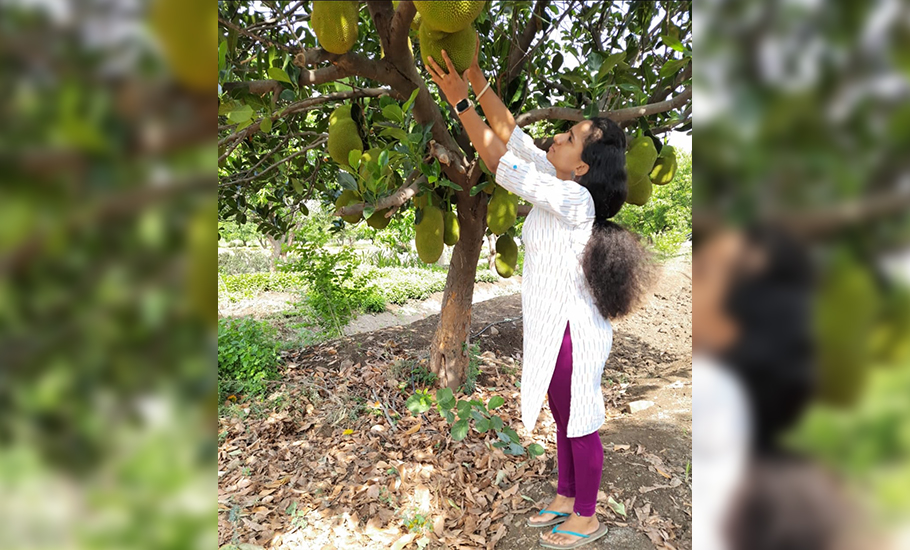
- Home
- News
- Analysis
- States
- Perspective
- Videos
- Education
- Entertainment
- Elections
- World Cup 2023
- Features
- Health
- Business
- Series
- Economy Series
- Earth Day
- Kashmir’s Frozen Turbulence
- India@75
- The legend of Ramjanmabhoomi
- Liberalisation@30
- How to tame a dragon
- Celebrating biodiversity
- Farm Matters
- 50 days of solitude
- Bringing Migrants Home
- Budget 2020
- Jharkhand Votes
- The Federal Investigates
- The Federal Impact
- Vanishing Sand
- Gandhi @ 150
- Andhra Today
- Field report
- Operation Gulmarg
- Pandemic @1 Mn in India
- The Federal Year-End
- The Zero Year
- Premium
- Science
- Brand studio
- Home
- NewsNews
- Analysis
- StatesStates
- PerspectivePerspective
- VideosVideos
- Entertainment
- ElectionsElections
- Sports
- Loading...
Sports - Features
- BusinessBusiness
- Premium
- Loading...
Premium

What happened when a techie-turned-farmer ditched cotton crop for flowers

Every time Chinmayi Enugula ventures into her six-acre farm, the former IT professional is thrilled to see a new species of bird or insect. When the thought of making the switch from a techie to a farmer first occurred, Chinmayi did not expect her farm would one day become a sanctuary for rare birds and insects that no one had ever spotted earlier in Echoda, a village in Adilabad district...
Every time Chinmayi Enugula ventures into her six-acre farm, the former IT professional is thrilled to see a new species of bird or insect. When the thought of making the switch from a techie to a farmer first occurred, Chinmayi did not expect her farm would one day become a sanctuary for rare birds and insects that no one had ever spotted earlier in Echoda, a village in Adilabad district of Telangana.
The most frequent visitors to Chinmayi’s farm during the day are honeybees and butterflies while the nights get their sparkle from fireflies – again, a so far unknown sight in the area where agriculture is dominated by cotton and soya crops. Living close to the farmland where she grows flowers, Chinmayi wakes up to the pleasant, sometimes unfamiliar, chirping of birds every day.

Twenty-eight-year old Chinmayi’s farm has become the talk of the town for two conflicting reasons. Local farmers consider the use of land for floriculture as sheer under-utilisation of the valuable land as it fetches lower revenue than cotton and soya crops. On the other hand, many others praise the development as an inspirational step to restore the environment degraded by ‘toxic landscapes’ produced by cotton cultivation to its original glory.
Chinmayi, a former business analyst in a leading software company, had to quit her job when she tested positive for Covid. She returned to Echoda for isolation. Her prolonged suffering from complications arising out of Covid, left her disinterested in the job, but also gave her time to think about what she really wanted to do in life. Chinmayi then decided to experiment with agriculture on her six-acre ancestral farm.
It was no easy road, though. Chinmayi faced stiff resistance in the initial stages from relatives and other farmers in the neighbourhood who argued that organic farming won’t fetch as much money as cotton farming. Ignoring the resistance as a sign of pessimism, Chinmayi took to organic farming to grow flowers, an alien concept in the village.
To start off, she took back her land that had been leased out for cotton and soya cultivation. The use of organic manure quickly made the land suitable for floriculture and in just two years, the farmland was blooming with flowers all over.

What was she to do with all the flowers? To everyone’s surprise, the demand for flowers grew in no time and came from all across. Her farm is now the only supplier of flowers to decorators in Adilabad, acting as the single-window that offers all types of flowers that are in demand.
“Earlier, the decorators used to depend on brokers who brought flowers from Nagpur and other areas. This made flowers expensive. Now, they can buy nearly 15 to 20 varieties from my farm at a rate cheaper than that offered by brokers. The idea was a hit. I found a ready market. Even the public started coming to the farm to buy flowers because it was cheaper and there was variety on offer,” says a beaming Chinmayi.
She now makes about Rs 2,000 to Rs 3,000 a day without having to flood the farm with pesticides and poisonous chemical weed-killers. The six-acre agriculture plot, under Chinmayi’s care, has also become a visual delight in the region.
Still, many are not ready to accept floriculture as a viable alternative. “Flowers need constant care. You face labour issues as flowers require regular plucking. On the other hand, in cotton farming, you can simply forget the farm after sowing except for the periodic application of pesticides and other chemicals. The yield would be more and you get all the money in one go after harvesting cotton.”
Cotton farmers refuse to look beyond even though cotton farming is like gambling. Frequent crop failures and consequent debt traps have failed to motivate farmers to look for alternatives. Suicides among cotton farmers, meanwhile, remain high.
A total of 466 farmers died by suicide in Telangana in 2020, as per the Accidental Deaths and Suicides in India, 2020, released by the National Crime Records Bureau. Adding five agricultural labourers, a total of 471 people engaged in the farming sector died by suicide in 2020.
Death by suicides rose even in tribal belts once cotton farming started in the region. Giving up life, for whatever reason, had earlier been an unknown phenomenon in the primitive tribal communities. Farmers are generally cajoled by seed companies, pesticide dealers and money lenders into cotton farming. Another reason farmers prefer cotton, which survives low rainfall and guarantees a minimum yield, is the damage caused to food crops by monkeys and wild boars.
And so Chinmayi’s farm Echoda, blooming with about 30 types of flowers, stands out like a green oasis, in the midst of sprawling monoculture cotton fields.
The pleasant consequence of this is the return of swarms of honeybees along with many types of insects and tiny birds that had disappeared decades ago with cotton cultivation that made the environment uninhabitable for these creatures.

Chinmayi is surprised by the sheer number of honeycombs that are found everywhere on the farm. “Earlier, we used to see one or two honeycombs on mango trees. Now, we find them everywhere, near the rose beds, jasmines, and other flowers, each comb producing a distinct honey with the flavour of the surrounding flowers. I am planning to harvest the honey also,” Chinmayi says, adding she had never seen dozens of species of insects and birds, all in the same area, though she spent her childhood in the village.
“Every time I visit the farm, I spot a new or rare bird flitting across the field. Although we are close to the forest, such a beautiful spectacle, birds and insects making our farm their home, is new. When the garden is in full bloom, one can see thousands of honeybees, butterflies and insects competing to land on flowers,” she says. Organic farming, she adds, has rejuvenated the natural habitat of these creatures preparing the conditions for their return.
Why the guests had disappeared
Lauding Chinmayi’s experiment as a role model for others, Dr Nanda Kishore Kannuri, a scientist from the Indian Institute of Public Health (IIPH), Hyderabad, says the decades-long Bt cotton cultivation has produced ‘toxic landscapes’ all across Telangana, including the Adilabad district, which drove away all human friendly creatures from nearby environment.
According to Kannuri, who extensively studied the impact of Bt cotton cultivation on human populations and environment, the environmental damage in Telangana coincided with the introduction of Bt cotton which slowly spread to all climatic zones including semi-arid and rain-fed areas of the state.
“Farmers have shifted to commercial cotton cultivation from subsistence agriculture even in tribal areas because of a ready market and huge return. However, cotton cultivation and the inevitable use of agrochemicals — fertilisers, herbicides and pesticides — led to large-scale environmental damage. What is more distressing is that monoculture — cropping of a single variety in all seasons — has led to the extinction of native germplasm and loss of genetic diversity,” Kannuri says.
“Such areas are called toxic landscapes. No birds or insects can survive in the toxic landscapes created by cotton fields and this might have led to the disappearance of honeybees and other creatures in the area. Honeybees are highly sensitive to environmental changes. Organic farming and the absence of poisonous chemicals led to the rejuvenation of the natural habitat of these insect creatures. So they rushed back home,” he adds.
Kannuri warns that the cotton yield would come down after some time necessitating intense application of expensive pesticides which is bound to further damage the environment.
“Any crop failure at that point is bound to throw the farmer into a debt trap. This was precisely the reason for suicides among tribal farmers of the Adilabad district. So, new models of farming like the one being practised by Chinmayi should be promoted by all stakeholders,” he says.
The role of Bt toxin
Dr Ashok Kumbamu, a scientist from Mayo Clinic in Florida, US, says cotton plants themselves act like an insecticide repellent, killing insects irrespective of their species. Kumbamu was among the first batch of scientists who studied Bt cotton’s impact on society and the environment in the mid-2000s.
Talking to The Federal from Florida, he says, the Bt cotton monocropping culture transforms the surrounding environment into a sterile one, without any human-friendly insects or birds that depend on the nectar of flowers. The Bt toxin that emanates from crops drives away insects and birds from the cotton fields destroying the ecological diversity.
“As with any other crop, insects that are exposed to Bt crops will eventually develop resistance to the poisonous substance, Bt toxin, that the crop produces. Considering this, a proactive insect resistance management system was put together by seed companies to delay or prevent the development of Bt resistance in insects,” says Kumbamu.

According to Kumbamu, the resistance management plan suggests a refuge strategy of planting non-Bt cotton in at least five rows surrounding the Bt cotton field, or 20 per cent of the total sown area, whichever is greater. The logic, he says, is that when non-Bt cotton is planted within or around a Bt cotton field, the non-Bt cotton acts as a refuge for Bt-susceptible insects that will mate with Bt-resistant insects, and produce Bt-susceptible offspring, thereby minimising or delaying the development of Bt-resistant insects. This is not possible in India. “Leaving 20 per cent of land for non-Bt cotton which is vulnerable to pests is not a viable proportion as the majority of landholdings are small and farmers are small and marginal. So, the damage has become uncontrollable,” Kumbamu explains.
Both Kannuri and Kumbamu suggest that attempts should be made to divert cotton farmers towards sustainable models which rejuvenate and restore the environment. And this is why, they believe, Chinmayi’s floriculture experiment is worth emulating.

